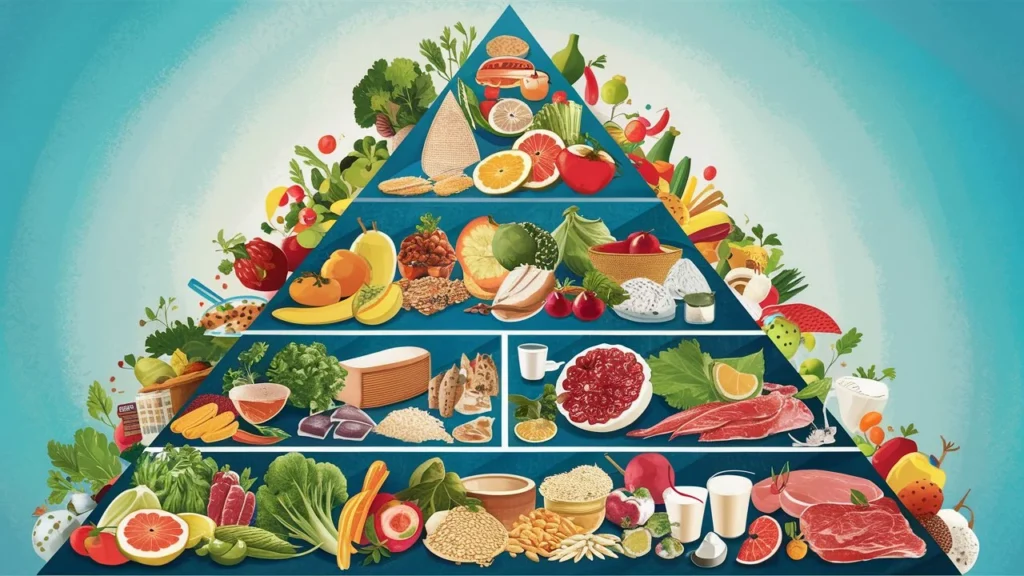The Importance of Food Diversity Meals
Table of Contents
Ensuring that children receive a balanced diet is a cornerstone of their health and development. However, food diversity is often overlooked as a key component of a balanced diet. It involves incorporating a wide variety of foods from different food groups, such as fruits, vegetables, grains, proteins, and healthy fats, to provide a range of essential nutrients. This article explores the importance of food diversity in children’s meals, the benefits it offers, and practical ways to achieve it.
1. Understanding Food Diversity
Food diversity means including different foods in a child’s diet, which allows for the intake of a broad spectrum of nutrients essential for health and development. For example, while proteins support muscle growth and repair, fruits and vegetables are rich in vitamins, minerals, and antioxidants. A diet lacking in diversity can lead to nutrient deficiencies, affecting both physical and cognitive growth.
2. The Nutritional Benefits of a Diverse Diet

A varied diet offers numerous benefits:
- Improved Nutrient Intake: Diverse foods provide a more comprehensive range of nutrients. Different food types contain specific vitamins, minerals, proteins, carbohydrates, and fats. For example, vitamin C from citrus fruits boosts the immune system, while omega-3 fatty acids from fish are essential for brain development.
- Enhanced Gut Health: Different foods contain various types of dietary fibers, which help promote a healthy digestive system. Fermented foods like yogurt introduce beneficial bacteria to the gut, improving digestion and potentially reducing the risk of chronic gastrointestinal issues.
- Reduced Risk of Deficiency Diseases: A diet limited to a few food types can lead to deficiencies in essential nutrients like iron, calcium, and vitamin D. Including a variety of foods ensures that these needs are met more effectively.
3. Psychological and Behavioral Benefits
Food diversity also has important psychological and behavioral advantages for children:
- Encourages Healthy Eating Habits: Introducing children to different flavors, textures, and food types encourages them to be open to trying new foods. This openness can reduce picky eating tendencies and promote a lifelong habit of eating well-balanced meals.
- Improves Mood and Behavior: There is evidence that a diverse and balanced diet can positively influence children’s mood and behavior. For instance, diets rich in fruits, vegetables, and healthy fats are linked to lower rates of behavioral problems in children, while diets high in sugar and processed foods may contribute to mood swings and hyperactivity.
4. Food Diversity and Cognitive Development

The brain, being a metabolically active organ, requires a constant supply of diverse nutrients for proper functioning:
- Brain-Boosting Nutrients: Omega-3 fatty acids (from fish), zinc (from lean meats), iron (from leafy greens), and B vitamins (from whole grains) are essential for cognitive functions such as memory, concentration, and problem-solving. A lack of these nutrients can impair cognitive development and academic performance.
- Antioxidants and Cognitive Health: Foods rich in antioxidants, such as berries and nuts, protect the brain from oxidative stress, which can impair learning and memory. Consuming a variety of antioxidant-rich foods supports cognitive health over time.
5. Food Diversity Guidelines for Different Age Groups
Different age groups have distinct nutritional requirements that should be considered when planning a diverse diet. Below is a table summarizing the general dietary guidelines for children based on age:
| Age Group | Nutritional Needs | Examples of Diverse Foods |
|---|---|---|
| Infants (0-6 months) | Mainly breast milk or formula; gradual introduction to solid foods | Start with pureed vegetables and fruits, then introduce grains |
| Toddlers (7-24 months) | High nutrient density; introduction to finger foods and varied textures | Soft meats, whole grains, dairy, fruits, and small pieces of vegetables |
| Preschoolers (2-5 years) | Balanced diet with appropriate portion sizes | Lean proteins, whole grains, colorful fruits and vegetables, dairy |
| School-aged (6-12 years) | Support for growth spurts and active lifestyle | Varied protein sources, whole grains, legumes, nuts, and seeds |
| Teenagers (13-18 years) | Higher energy needs, focus on bone health and cognitive function | Fish, leafy greens, dairy, eggs, avocados, nuts, and diverse fruits |
6. Challenges to Achieving Food Diversity
While the benefits are clear, there are common barriers that can make it difficult for parents to provide a diverse diet:
- Picky Eating: Children often develop strong food preferences or aversions. To overcome this, try introducing new foods gradually or incorporating them into familiar dishes.
- Allergies and Sensitivities: Food allergies can limit options. However, alternatives exist for most common allergens. For instance, if a child is allergic to dairy, calcium-fortified plant-based milks are a good substitute.
- Cultural and Socioeconomic Factors: Access to diverse foods may be limited by location or income. In these cases, frozen or canned fruits and vegetables (without added sugar or salt) can be suitable alternatives. Community programs and food banks often provide resources for families in need.
7. Practical Tips for Encouraging Food Diversity
- Start Early: Expose children to a wide range of foods when introducing solids. Research shows that early exposure increases the likelihood of accepting various foods later in life.
- Make It Fun: Present foods in appealing shapes and colors. Use cookie cutters for fruits or serve “rainbow” meals featuring different colored vegetables.
- Family Meals: Eating as a family can encourage children to try new foods by modeling healthy eating behaviors.
- Rotate Foods: Avoid serving the same meals every day. Try introducing a new fruit or vegetable each week to keep meals interesting.
- Involve Kids in Cooking: Allowing children to help in the kitchen gives them a sense of ownership over their food choices, making them more willing to try diverse foods.
8. Limiting Processed Foods and Sugary Beverages

One way to enhance food diversity is to reduce the consumption of processed foods and sugary beverages, which are often nutritionally poor. Here’s a table comparing typical nutritional values between whole foods and their processed counterparts:
| Food Type | Whole Food Option | Processed Food Option |
|---|---|---|
| Protein | Grilled chicken breast (high in lean protein) | Chicken nuggets (high in fat and sodium) |
| Snack | Fresh fruit (natural sugars, fiber, vitamins) | Fruit snacks (added sugars, low fiber) |
| Beverage | Water or milk (hydration, calcium, no sugar) | Soda (high in added sugars, empty calories) |
| Breakfast | Oatmeal with berries (fiber, antioxidants) | Sugary cereals (high in sugar, low in fiber) |
9. Common Myths About Children’s Nutrition and Food Diversity
There are several misconceptions regarding children’s nutrition, such as the idea that “kids only need to eat what they like.” While preferences should be respected, it is important to gently encourage the introduction of new foods.
FAQ
Q1: Why is food diversity important for children?
A1: It ensures a comprehensive range of nutrients necessary for physical growth, cognitive development, and overall health.
Q2: What if my child is a picky eater?
A2: Introduce new foods gradually, offer a variety of options in small portions, and avoid pressuring the child to eat.
Q3: Can frozen vegetables be as nutritious as fresh ones?
A3: Yes, frozen vegetables are often frozen at their peak ripeness and retain similar nutritional value to fresh vegetables.
Q4: How much variety should there be in a child’s diet?
A4: Aim for a colorful plate with different food groups at each meal. Variety across meals throughout the week is more important than achieving diversity in a single meal.
10. Case Studies and Statistics
Several studies have shown that diets rich in food diversity are linked to better health outcomes. For instance, a study published in The American Journal of Clinical Nutrition found that children who consumed a wide variety of foods, including fruits, vegetables, whole grains, and proteins, had lower rates of obesity and better academic performance compared to those with limited diets.
The table below summarizes findings from various research on the benefits of diverse diets:
| Research Study | Findings | Year |
|---|---|---|
| The American Journal of Clinical Nutrition | Diverse diets linked to lower obesity rates | 2018 |
| Journal of Child Psychology and Psychiatry | Food variety associated with fewer behavioral problems | 2016 |
| Journal of Nutrition | High food diversity correlated with improved cognitive function | 2019 |
| Public Health Nutrition | Diverse diets led to fewer cases of nutrient deficiencies | 2017 |
Conclusion
Food diversity is essential in children’s meals for both their physical health and cognitive development. A diet that includes a wide variety of foods helps ensure that children get the full range of nutrients needed to thrive. Parents should aim to introduce a mix of foods, limit processed items, and encourage healthy eating habits from a young age. Overcoming challenges like picky eating and access limitations can make a significant difference in the long-term health and well-being of children.
References
- The American Journal of Clinical Nutrition. (2018). “Food diversity and its relation to obesity in children.”
- Journal of Child Psychology and Psychiatry. (2016). “The effects of diet variety on children’s behavioral outcomes.”
- Journal of Nutrition. (201







